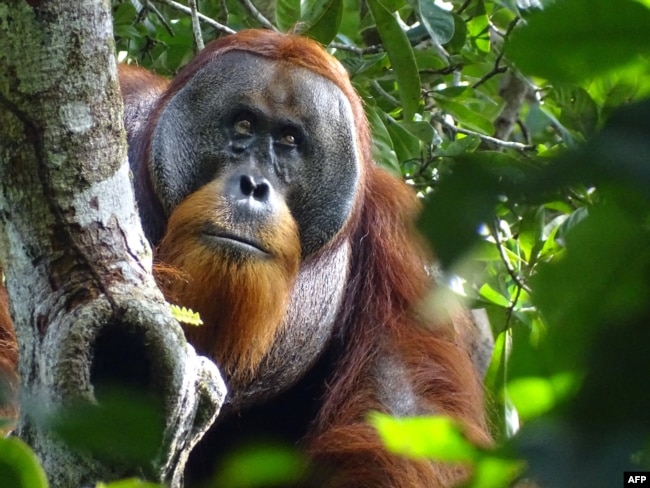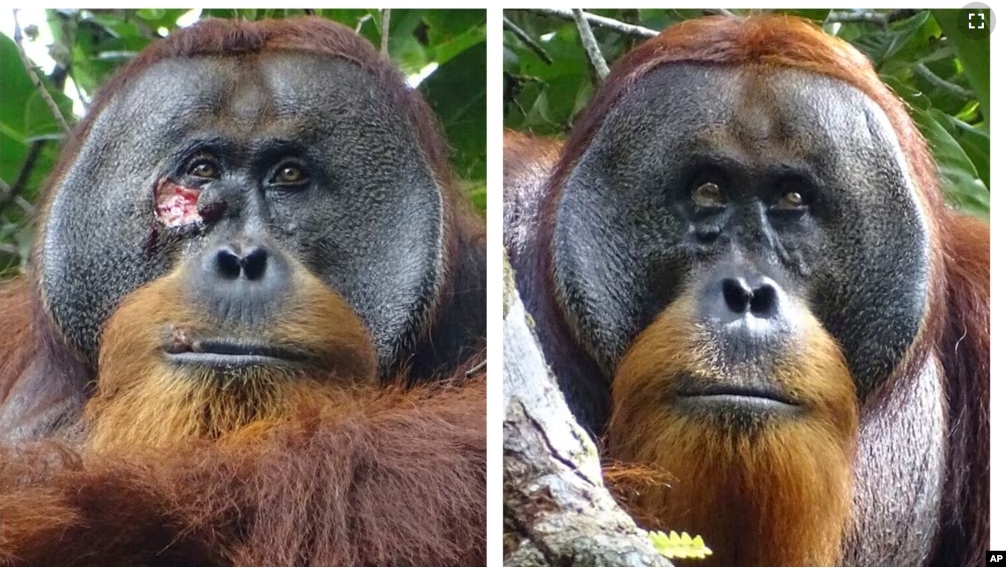Researchers say a wild orangutan in Indonesia appeared to use a medicinal plant to treat a wound it had suffered. The observation represents the latest example of how some animals attempt to treat their own sickness or injury with medicines found in the wild, the scientists reported recently.
The adult male orangutan lives in Indonesia’s Gunung Leuser National Park. The researchers call him Rakus. They observed the animal pick and chew leaves of a medicinal plant. Then, he used his fingers to spread the plant juices across an injury on his face. Afterward, he used the chewed material to cover the open wound, the researchers said in a new study in Scientific Reports.
People throughout Southeast Asia use the same plant to treat pain and inflammation.
Earlier research documented several kinds of great apes looking for medicines in forests to heal themselves. However, scientists had not yet seen an animal treat itself in this way.
Study co-writer Isabelle Laumer of the Max Planck Institute of Animal Behavior in Konstanz, Germany, said, “This is the first time that we have observed a wild animal applying a quite potent medicinal plant directly to a wound.”

Ulil Azhari, a co-writer and field researcher at the Suaq Project in Medan, Indonesia, first recorded the orangutan’s behavior in 2022. Photographs show the animal’s wound healed and closed within a month.
Scientists have been observing orangutans in Indonesia’s Gunung Leuser National Park since 1994, but they had not seen this behavior before.
“It’s a single observation,” said Emory University biologist Jacobus de Roode, who was not involved in the study. “But often we learn about new behaviors by starting with a single observation.”
“Very likely it’s self-medication,” said de Roode, adding that the orangutan applied the plant only to the wound and no other body part.
It is possible Rakus learned the treatment method from other orangutans living outside the park, said co-writer Caroline Schuppli at Max Planck.
Rakus was born and lived outside the study area when he was young. Researchers believe the orangutan got hurt in a fight with another animal.
Scientists have recorded other kinds of primates using plants similarly.
Bornean orangutans rubbed themselves with juices from a medicinal plant, possibly to reduce body pains or chase away parasites.
Chimpanzees in several places have been seen chewing on plants that can help ease stomach pain. Gorillas, chimpanzees and bonobos swallow some kinds of rough leaves whole to kill stomach parasites.
Tara Stoinski of the nonprofit Dian Fossey Gorilla Fund said, “If this behavior exists in some of our closest living relatives, what could that tell us about how medicine first evolved?”
Stoinski had no part in the study.
I’m John Russell.
Christina Larson reported on this story for the Associated Press. John Russell adapted it for VOA Learning English.
________________________________________
Words in This Story
orangutan – n. a kind of large ape that has reddish-brown hair
potent – adj. very strong or effective
